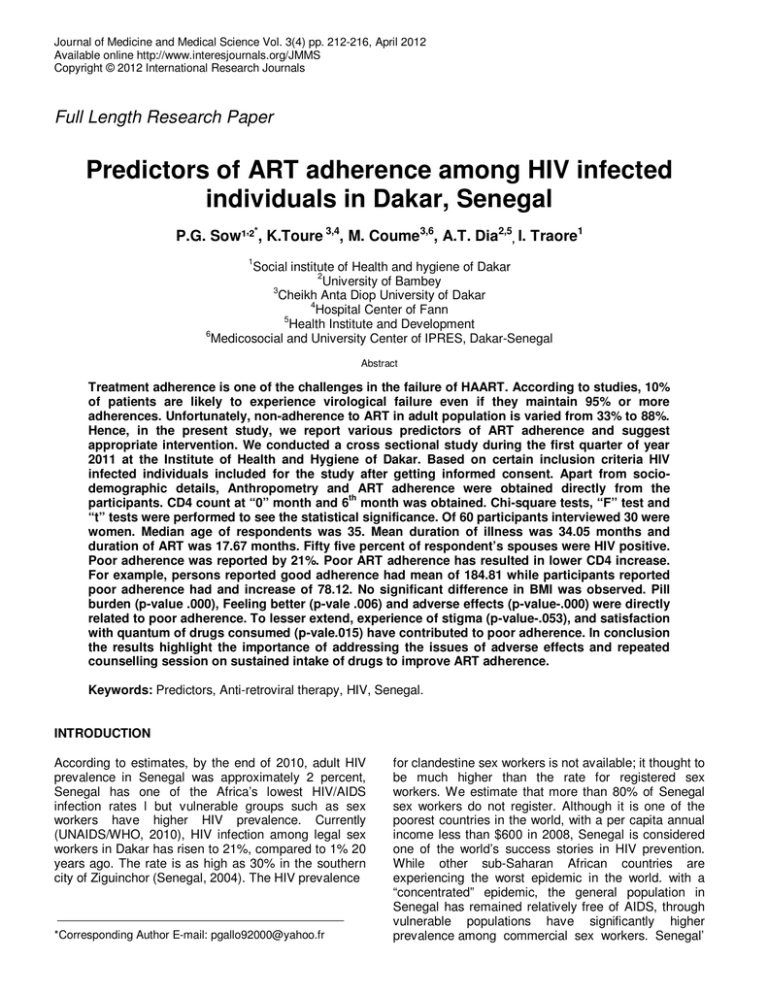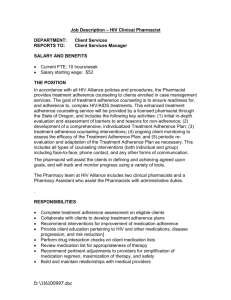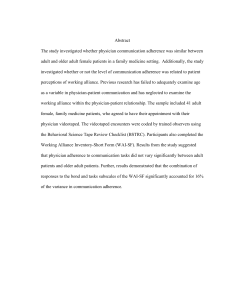Document 14240000
advertisement

Journal of Medicine and Medical Science Vol. 3(4) pp. 212-216, April 2012 Available online http://www.interesjournals.org/JMMS Copyright © 2012 International Research Journals Full Length Research Paper Predictors of ART adherence among HIV infected individuals in Dakar, Senegal P.G. Sow¹,²*, K.Toure 3,4, M. Coume3,6, A.T. Dia2,5, I. Traore1 1 Social institute of Health and hygiene of Dakar 2 University of Bambey 3 Cheikh Anta Diop University of Dakar 4 Hospital Center of Fann 5 Health Institute and Development 6 Medicosocial and University Center of IPRES, Dakar-Senegal Abstract Treatment adherence is one of the challenges in the failure of HAART. According to studies, 10% of patients are likely to experience virological failure even if they maintain 95% or more adherences. Unfortunately, non-adherence to ART in adult population is varied from 33% to 88%. Hence, in the present study, we report various predictors of ART adherence and suggest appropriate intervention. We conducted a cross sectional study during the first quarter of year 2011 at the Institute of Health and Hygiene of Dakar. Based on certain inclusion criteria HIV infected individuals included for the study after getting informed consent. Apart from sociodemographic details, Anthropometry and ART adherence were obtained directly from the participants. CD4 count at “0” month and 6th month was obtained. Chi-square tests, “F” test and “t” tests were performed to see the statistical significance. Of 60 participants interviewed 30 were women. Median age of respondents was 35. Mean duration of illness was 34.05 months and duration of ART was 17.67 months. Fifty five percent of respondent’s spouses were HIV positive. Poor adherence was reported by 21%. Poor ART adherence has resulted in lower CD4 increase. For example, persons reported good adherence had mean of 184.81 while participants reported poor adherence had and increase of 78.12. No significant difference in BMI was observed. Pill burden (p-value .000), Feeling better (p-vale .006) and adverse effects (p-value-.000) were directly related to poor adherence. To lesser extend, experience of stigma (p-value-.053), and satisfaction with quantum of drugs consumed (p-vale.015) have contributed to poor adherence. In conclusion the results highlight the importance of addressing the issues of adverse effects and repeated counselling session on sustained intake of drugs to improve ART adherence. Keywords: Predictors, Anti-retroviral therapy, HIV, Senegal. INTRODUCTION According to estimates, by the end of 2010, adult HIV prevalence in Senegal was approximately 2 percent, Senegal has one of the Africa’s lowest HIV/AIDS infection rates l but vulnerable groups such as sex workers have higher HIV prevalence. Currently (UNAIDS/WHO, 2010), HIV infection among legal sex workers in Dakar has risen to 21%, compared to 1% 20 years ago. The rate is as high as 30% in the southern city of Ziguinchor (Senegal, 2004). The HIV prevalence *Corresponding Author E-mail: pgallo92000@yahoo.fr for clandestine sex workers is not available; it thought to be much higher than the rate for registered sex workers. We estimate that more than 80% of Senegal sex workers do not register. Although it is one of the poorest countries in the world, with a per capita annual income less than $600 in 2008, Senegal is considered one of the world’s success stories in HIV prevention. While other sub-Saharan African countries are experiencing the worst epidemic in the world. with a “concentrated” epidemic, the general population in Senegal has remained relatively free of AIDS, through vulnerable populations have significantly higher prevalence among commercial sex workers. Senegal’ Sow et al. 213 success at maintaining low overall prevalence has been attributed to the confluence of a number of factors, including strong political leadership, early involvement and leadership among religious leaders, conservative cultural norms regarding sexual practices, and a comprehensive strategic approach implemented early in the epidemic. (UNAIDS/WHO, 2009). The degree of government commitment in the fight against AIDS is visible in its well developed public sector ART program, the Initiative Senegalese Access aux ARV (ISAARV) (UNAIDS/WHO, 2006). With the advent of highly active antiretroviral therapy (HAART), in 1998, more number of people are put on ART every day in Senegal. Today, with the availability of ART treatment, HIV-infected patients are living. In order to obtain full benefit of ART, near Perfect and sustained adherence to treatment is critical. Unfortunately, nonadherence is common among individuals treated with HAART. Several studies have shown varying levels of adherence. (Deeks et al., 1997; Safren et al., 2005) .Reasons for adherence or poor adherence differ from place to place and are multi- dimensional in nature. From provider’s perspective lack of trust between clinician and patient (Nischal et al., 2005), counseling services provided (Sharma et al., 2007), waiting hours all contribute to good or poor adherence. From the receivers perspective, there can be several issues starting from fear of disclosure, stigma, alcohol or substance abuse, number of pills required, financial burden (Sama et al., 2008) . Currently adherence assessment is not done and rate is not available as a result no preventive strategies are adopted to reduce treatment non-adherence. Hence, this study was planned to identify important barriers to treatment adherence among HIV infected individuals in Senegal and suggests ways and means to address the issue of non-adherence. METHODS The anti-retroviral treatment (ART). Center located at the Institute of Health and Hygiene Sociale in Dakar has patients on ART which include male, women, Trans gender and children. The HIV infected individuals who were started on treatment six month prior to date of interview and given consent were included for the study. A structured interview schedule was used to collect information on the socio-demographic characteristics such as age, gender, education, occupation, marital status, spouse HIV status and income etc., Participants also completed a brief HIV questionnaire related to self and that of family members’ questionnaire. Information on shopping for HIV was collected. Anthropometry was performed to measure BMI. Interviews were conducted at the ART center. Participants were informed of the study objectives and procedures prior to data collection. Thus obtained, data were entered in Excel spread sheet followed by data cleaning and recoding. Further data analysis was performed in SPSS version 11(SPSS inc. Chicago, IL, USA). Univariate analysis was performed to compare demographic and socio-economic characteristics of patients using X2 test regression was performed to assess the factors influencing ART adherence of HIV infected Individuals. RESULTS Of 60 participants interviewed 30 were women. Median age of respondents was 35 years. Fifty five percent of respondent’s spouses were HIV positive. Respondents mean age at marriage was 20 years and 21 years for their spouses. Twenty two respondents were illiterate and other details are presented in table 1. Majority of the respondents sought treatment in a public hospital. Thirty six percent of respondents sought treatment at private hospitals before seeking treatment in the public hospital. HIV test results were disclosed to the respondents to 73.3% by the counsellors. Five respondents did not disclose their HIV status to their spouses. For 45% of the respondents, their spouse either HIV negative or HIV status is not known. Mean CD4 count at 0 months for respondents was 129.47 SD (314.23) and at month was 314.23 SD(147.927).Mean BMI score was just about 19.09 SD(2.93). Mean duration of illness was 34.05 months and duration of ART was 17.67 months (Table 2). Poor adherence was reported by 21%. Poor ART adherence has resulted in lower CD4 increase. For example, persons reported good adherence had mean of 184.81 while participants reported poor adherence had and increase of 78.12. No significant difference in BMI was observed (Table 3). Logistic regression analysis has shown that Pill burden (p-value .000), Feeling better (p-value .006) and adverse effects (p-value-.000) were directly related to poor adherence. To lesser extend, experience of stigma (p-value-.053), and satisfaction with quantum of drugs consumed (p-vale.015) have contributed to poor adherence (Table 4). Participants who were started on treatment with low CD4 count were more likely to maintain poor adherence and eventually end up with lower CD4 count increase. Participants whose mean CD4 count was relatively high at the time of initiation of ART had higher mean CD4 count 6 months. DISCUSSION The study findings are in consistent with previous findings that the rate of treatment adherence is relatively poor (Sama et al., 2008). Adverse effects of drug and pill burden appears to be the primary factors that influence ART adherence. Though addressing these two issues is a difficult task, yet some efforts may be needed to reduce non- 214 J. Med. Med. Sci. Table 1. Socio demographic characteristic of the participants Factors Male Female Sex Age in years Spouse Age Marital Status Married Separated Age at Marriage Spouse age at Marriage Mean Family Size(adult) Mean Family Size(Children) Illiterate Literate Illiterate Literate Daily wage skilled Unemployed/ Housewife Daily wage skilled Unemployed/ Housewife Literacy S. Education Occupation Spouse Occupation Duration of illness(in Months) Place of Treatment seeking Place of screening Result disclosure Disclosure to spouse Spouse HIV status Frequency % 30 50 30 50 85 5 91.7 8.3 Mean 1.58 Mean 1.78 13 47 17 43 37 9 14 21.7 78.3 28.3 71.7 61.7 15 23.3 39 12 9 65 20 15 Mean 34.05 Private 22 Govt 57 Self 1 Traditional 2 healers Private Hospital 18 VCTC/Govt 24 VCTC/NGO 2 Private lab 1 Counselor 44 Doctor 13 Technician 1 Not informed 2 No 5 Yes 55 Positive 33 Negative 16 Unknown 7 Median 35SD(7.139) .600 34(8.107) .000 20.50SD(4.959) 21SD(4.640) SD 1.046 SD .904 .000 .000 .000 .000 SD 36.7 95 2 3.3 23.596 73.3 21.7 3.3 1.7 73.3 21.7 1.7 3.3 8.3 91.7 55 26.7 18.3 3 Table 2. Bio Markers of HIV patients Parameters Duration of Illness (in months) Duration of ART CD4(0 month) CD4(6 Month) BMI 2 X 1.00 Mean 34.05 Std. Deviation 23.596 17.67 129.47 314.23 19.098 9.24 314.23 147.927 2.9356 .000 .000 .000 .000 Sow et al. 215 Table 3. Adherence Vs biological parameters (BMI and CD4 count at 0 and 6 month) Factors Number CD4 0 Months CD4 6 months BMI Good Adherence 47 135.77 320.58 19.004 Poor Adherence 13 106.69 288.27 19.438 Table 4. Logistic regression values on predictors of ART adherence Sl.no 1 2 3 4 5 6 Prdictors Pill Burden Stigma Feel Better Adverse Effect Satisfied with Drug Service availed at Public facility adherence. Combined pill forms, half-longer life drugs (e.g. single daily dose) or longer acting controlled release forms may become important strategies in improving compliance with anti-retro viral therapy (Mehta et al., 1997). As documented by Mehta et al some of or all of the commonest side effects like leucopenia, anemia, transfusion and gastrointestinal might have influenced decreased adherence among our study participants too. In congruence with previous studies Lower baseline CD4 count found to negatively affecting ART (Sama et al., 2008). Currently in all patients, regardless of their condition, only receive free ARVs if their CD4 count is less than 200. Mean CD4 count at baseline of our study participants was 129.47. Hence efforts can be made to enrol HIV patients to ART programme with higher CD4 counts, if possible. Stigma as reported by previous studies (Safren et al., 2005), appear to its influence in treatment adherence. Since the early days of the AIDS epidemic, stigma and discrimination have been recognized as obstacles to HIV prevention, treatment and support (UNAIDS 2010). Particularly internalized stigma appeared to manifest in feelings of shame, hopelessness and guilt, social withdrawal and eventually lead to a tendency not to use existing treatment or support services (Thomas et al., 2005). Therefore, pre-treatment interventions that aim to reduce non-adherence should consider these predictors and concentrate on the following the issues, in an attempt to dispel the doubts the patients may have on the following aspects. Achieve good rapport and asses behavioural skills such as goal setting, assertiveness and problem solving. Covey the common probable side effects of ART to the patients. This awareness the patients confidence in the physician and hence the adherence, Anticipate side F-value 13.630 3.886 8.261 13.630 6.254 (t-test) 46.000 P-value .000 .053 .006 .000 .015 .083 effects and treat them as soon as possible. This should be followed by nutritional supplement as most of them do not have enough means to meet their dietary requirements. Pill fatigue or treatment fatigue is quite common among any person who requires long term treatment. This is exactly true with HIV infected patients who require consuming drugs for lifetime. Hence, intensive and regular monitoring is the only solution. Further in clinical practice, the most efficient method is to simply ask the patient in supportive and non-judgemental manner (Sakett, 1975) CONCLUSION Further, the information on adherence was obtained by self reporting, hence, its authenticity is not clearly known. Hence, findings from these analyses suggest, in addition to planning for interventions mentioned above, development of alternate assessment tools to measure treatment adherence may be useful to obtain predictors of ART adherence among HIV infected individuals. REFERENCES Deeks SG, Smith H, Holodiny M, Khan J (1997), HIV-1 Proteas inhibitors.A review for clinicians, J. Ame. Med. Assoc. 277:145-153. Mehta S, Moore RD, Graham NMH (1997). Potential factors effecting adherence with HIV therapy; AIDS -Volume 11(14): 1665-1670 Nischal KC, Khopkar U, Saple DG (2005). Improving adherence to antiretroviral therapy. Indian J. Dermatol. Venereol. Leprol. SepOct. 71(5):316-20. Sackett DL, Haynes RB, Gibson ES, Hackett BC, Taylor DW, Roberts RS, (1975). Randomized clinical trial of strategies for improving medication compliance in primary hypertension. Lancet.1:1205-7 Safren SA, Kumarasamy N, James R, Raminani S, Solomon S, Mayer KH (2005). Adherence, demographic variables and CD4 outcome among HIV-positive patients on antiretroviral therapy in Chennai, India.AIDS Care. Oct. 17(7):853-62. 216 J. Med. Med. Sci. Sarna A, Pujari S, Sengar AK, Garg R, Gupta I, Dam J (2008). Adherence to antiretroviral therapy and its determinants amongst HIV patients in India. Indian J. Med. Res. 127(1):28-36. Sharma M, Singh RR, Laishram P, Kumar B, Nanao H, Sharma C, Ahmed T (2007). Access, adherence, quality and impact of ARV provision to current and ex-injecting drug users in Manipur (India): an initial assessment. Int. J. Drug Policy. 18(4):319-25. Thomas BE, Rehman F, Suryanarayanan D (2005). How stigmatizing is stigma in the life of people living with HIV: a study on HIV positive individuals from Chennai, South India. AIDS Care 17(7):795-801). UNAIDS/WHO (2009 February), “UNAIDS guidance note on HIV and sex worker UNAIDS/WHO Report on the global AIDS Epidemic, May 2010. UNAIDS/WHO. Epidemiological fact sheets on HIV/AIDS and sexually transmitted infections: update 2009.


